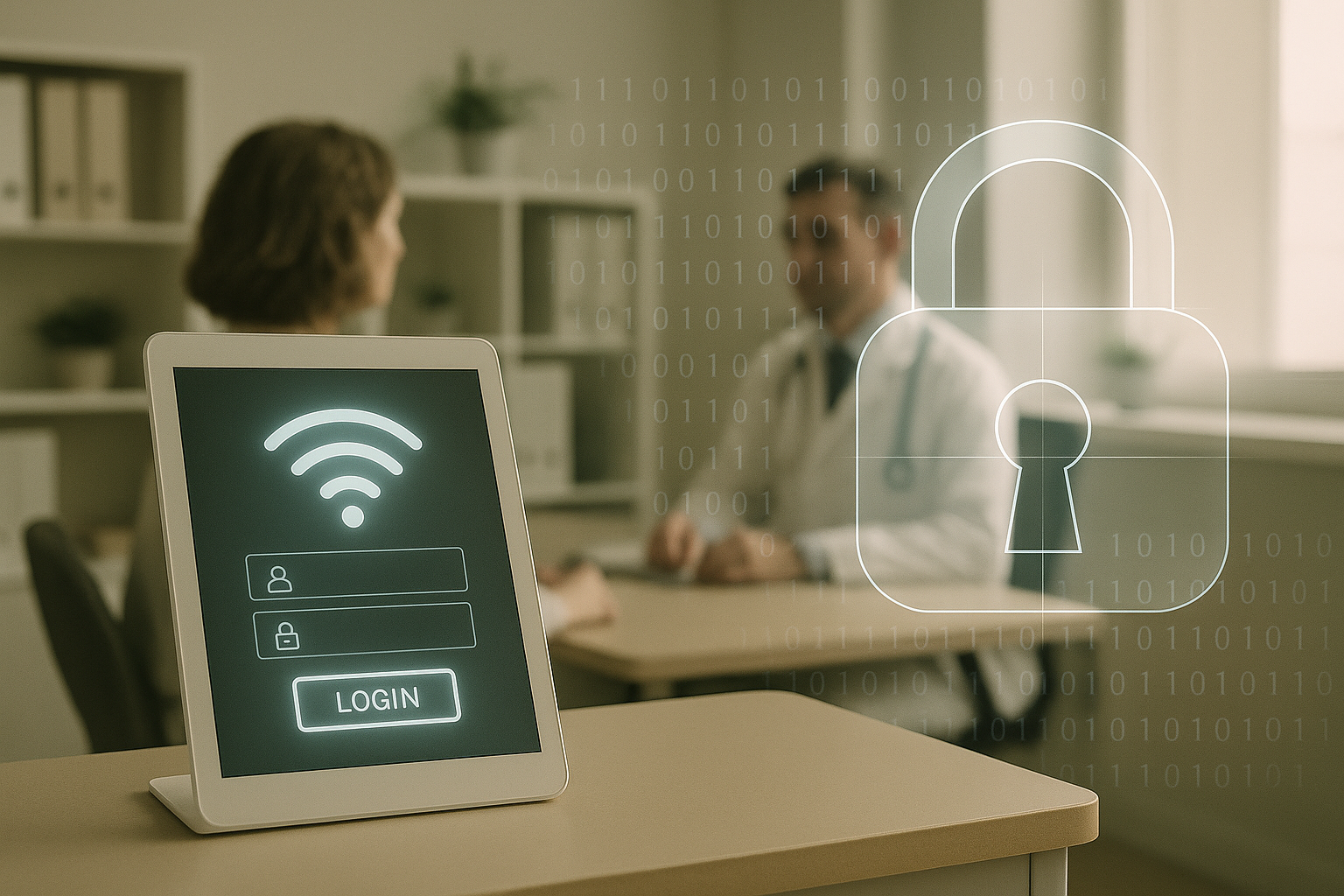Are you providing guest WiFi in your clinic without proper network isolation from clinical systems?
Patients expect reliable WiFi, which ranks among the top requested amenities in satisfaction surveys. But in healthcare settings, guest WiFi isn't just a convenience decision. It's where patient experience, information security, and regulatory compliance collide.
Guest WiFi must be welcoming and frictionless for patients while remaining isolated, secure, and HIPAA-compliant. A poorly designed guest network creates liability exposure and ransomware entry points. An overly restrictive one frustrates the people you're trying to serve.
Captive portals (those login pages that appear when users first connect to WiFi) sit at the center of this balance. When designed properly, they protect clinical networks while creating positive patient touchpoints. When designed poorly, they become security vulnerabilities.
What Is a Captive Portal in Healthcare?

A captive portal is a web page that appears when users connect to WiFi, requiring interaction before granting network access.
The technical flow: Patient's device connects. Device attempts to reach any website. Network intercepts that request and redirects to the portal. User sees your login screen, accepting terms and entering credentials. Once completed, network grants access.
In healthcare facilities, this portal serves five functions:
Network segmentation enforcement. The portal acts as a gatekeeper between guest devices and internal clinical networks. Electronic health records, medical IoT devices, and staff workstations operate on completely separate network segments.
Branding and communication. The splash page displays your facility's logo, welcome message, and practical information like visiting hours.
Terms of service acceptance. Users explicitly acknowledge acceptable use policies before accessing network resources. This creates a documented consent trail.
Session control. You can enforce time limits, bandwidth restrictions, and device limits through the portal's backend.
Usage analytics without privacy violations. Properly configured portals capture aggregate usage data (connection counts, peak times, device types) without collecting protected health information.
The critical distinction: Your guest WiFi must operate on an entirely separate VLAN from clinical systems. Firewall rules explicitly prevent any traffic flow between these segments. A patient streaming video should have zero pathway to reach medical devices or patient records.
Why Healthcare Networks Are Particularly Vulnerable
Healthcare networks operate under more stringent regulatory requirements than almost any other industry.
HIPAA and Global Data Protection Frameworks
HIPAA mandates strict controls over any systems that could access, transmit, or store protected health information (PHI) in the United States. While guest WiFi doesn't directly handle PHI, it shares physical infrastructure with systems that do, creating potential attack vectors if not properly isolated.
HIPAA applies only to U.S. organizations or those serving U.S. residents. Outside the U.S., other regions have their own frameworks:
Europe - GDPR: Broader than HIPAA. Covers all personal data, not just health information. Hospitals, apps, insurers, and fitness trackers fall under its privacy rules. Consent and data minimization are key principles.
Canada -PIPEDA: National law governing private-sector data use, with provincial health-specific laws like PHIPA (Ontario) and HIA (Alberta).
United Kingdom - Data Protection Act 2018: Post-Brexit GDPR equivalent, nearly identical with added provisions for NHS.
Australia - Privacy Act 1988: Includes specific guidelines for medical information and how healthcare providers must store and share it.
Singapore - PDPA: Requires organizations, including hospitals, to obtain consent before collecting or sharing identifiable data.
While HIPAA is uniquely American, the core concept (protecting identifiable patient data) is global. Every modern healthcare system has a version of it.
Even minimal data collection can create compliance obligations. Capture a patient's email address that links to their patient status, and you've potentially created PHI requiring protection.
The compliance framework requires:
- Documented network segmentation through network diagrams, firewall rules, and penetration testing
- Audit trails for every authentication attempt and access grant
- Encryption for all portal communications using HTTPS
- Terms of use and consent documentation
- Incident response procedures for segmentation breaches
Healthcare-Specific Security Threats
Research indicates that 22% of hospitals have connected medical devices that inadvertently bridge guest and clinical networks, creating dangerous security gaps.
Medical device vulnerability. Many hospitals operate IoT devices (infusion pumps, patient monitors, imaging systems) that run outdated operating systems and cannot be easily patched.
High-value target status. Healthcare records sell for significantly more than credit card data, making hospitals attractive targets.
Ransomware propagation risk. Healthcare ransomware attacks often begin with compromised devices gaining initial network access, then spreading laterally.
Healthcare facilities cannot treat guest WiFi as an afterthought.
How to Improve Patient Experience Without Compromising Security
Security and compliance don't conflict with user experience. They require intentional design.
When Mediclinic hospitals in South Africa deployed free WiFi, patient satisfaction scores improved notably. Family members coordinated care remotely during extended stays. Patients maintained emotional connections with loved ones. Anxiety levels decreased when people could access familiar entertainment and communication tools.
Authentication Methods That Actually Work
Complex authentication procedures create abandonment. Patients don't have patience for lengthy registration forms.
SMS-based one-time passwords. Patients enter their mobile number, receive a code, and gain immediate access. This method works across all device types. Mediclinic uses this approach.
Room number authentication. Hospital patients authenticate using their room number combined with a simple PIN.
Social login options. Authentication through Google, Facebook, or Apple accounts eliminates credential management.
Pre-approved access. Staff can generate access codes for visitors of specific patients, creating controlled access without bottlenecks.
The critical principle: Collect the minimum information necessary. Additional data can be requested after initial connectivity.
Portal Design That Enhances Experience
Transform the portal into a branded experience:
- Display facility logo, colors, and welcome message
- Include visiting hours, dining options, and directions
- Provide content in multiple languages
- Ensure mobile optimization with touch-friendly buttons
- Include troubleshooting: "Not connecting? Try turning WiFi off and on"
Performance Requirements

Adequate bandwidth allocation. Guest networks should support video streaming, video calls, social media, and email without degradation.
Session management. Time-based session limits (4-8 hours) with automatic renewal prevent resource monopolization while accommodating legitimate needs.
Quality of Service policies. Network infrastructure should prioritize clinical traffic. Medical devices and clinical applications receive priority while guest traffic is throttled when bandwidth becomes constrained.
Essential Design Requirements
Network Segmentation (Non-Negotiable): Guest devices receive IP addresses from a dedicated VLAN with no routing pathway to internal hospital networks. Firewall rules explicitly deny traffic from guest VLANs reaching internal segments. WiFi network name for guest access should be distinct from staff networks. Implement intrusion detection systems, anti-spoofing filters, and regular penetration testing.
Authentication and Access Control: SMS-based OTP, room number authentication, or social login work well for patients through the captive portal. For healthcare workers accessing clinical networks, your IT team should configure enterprise-grade authentication (WPA3 Enterprise with RADIUS integration and multi-factor authentication) on your network infrastructure. Different user populations receive different access levels. Typically 2-3 devices for patients, 1-2 for visitors.
Terms of Use: Clearly state prohibited activities and consequences. Inform users what information is collected and how it's used. Require explicit consent through a checkbox, not passive acceptance.
Bandwidth and Session Management: Typical configurations provide 3-5 Mbps download speeds, sufficient for streaming without allowing excessive consumption. Four to eight-hour sessions with automatic renewal. Automatic disconnection after 30 minutes of inactivity prevents bandwidth waste.
Security Monitoring: Deploy systems that analyze guest network traffic for patterns indicating compromise (port scanning, unusual protocol usage, data exfiltration patterns). When suspicious activity is detected, automatically isolate the device and alert security teams. Maintain authentication logs according to your governance policies, typically 90 days to one year.
Compliance Documentation: Maintain current network diagrams showing segmentation, firewall rules, and traffic flow patterns. Document acceptable use policies, data collection practices, retention schedules, and incident response procedures. Have your portal design reviewed by legal counsel before deployment.
How Spotipo Addresses Healthcare Requirements
Spotipo's captive portal platform provides authentication and guest management features that align with healthcare facilities' needs, though we haven't yet deployed in clinical environments.
Important: Spotipo provides the guest WiFi authentication and portal layer. Network segmentation, firewall rules, and VLAN configuration must be implemented by your healthcare IT team on your existing router infrastructure (UniFi, MikroTik, Cisco, etc.). For HIPAA compliance questions specific to your deployment, consult with your legal and compliance teams.
Configure exactly what information is collected, from comprehensive forms to simple one-click access. Implement SMS-based OTP or social login that minimizes data capture. Create branded portal experiences. Healthcare organizations operating multiple locations manage all deployments from a centralized dashboard.
Support for SMS-based OTP, social login, email authentication, voucher codes, and custom workflows. Configure time-based session limits, bandwidth restrictions, device limits, and data quotas. View aggregate metrics about connection counts, device types, and usage patterns without collecting PHI. Spotipo works with properly segmented networks where your IT team has configured VLAN isolation on your router infrastructure. All portal communications use HTTPS with valid certificates.

Frequently Asked Questions
Is guest WiFi required for HIPAA compliance?
No, but if you provide it, HIPAA mandates strict network segmentation. Documentation of this segmentation is required during audits.
What authentication method works best?
SMS-based one-time passwords. Patients enter their mobile number, receive a code, and gain immediate access.
Can guest WiFi share access points with clinical networks?
Yes, but only with proper VLAN segmentation. Modern access points support multiple SSIDs on the same hardware, with each SSID assigned to separate VLANs.
What data can we legally collect?
Minimize collection to reduce compliance obligations. Collect only what's necessary for authentication.
How long should sessions last?
Four to eight hours with automatic renewal options. Automatic disconnection after 30 minutes of inactivity helps manage bandwidth.
What bandwidth limits work best?
3-5 Mbps download speeds per guest user, sufficient for streaming without allowing excessive consumption.
Making Healthcare Guest WiFi Both Safe and Patient-Friendly
Guest WiFi has evolved from a luxury amenity to a baseline expectation. But healthcare facilities cannot approach it the same way retail stores do.
The regulatory environment is more complex. The security stakes are higher. The consequences of network compromise extend beyond data theft to potential patient safety impacts.
Well-designed captive portals bridge the gap. They enforce network segmentation through VLAN isolation and firewall rules. They provide frictionless authentication using SMS OTP or social login. They create opportunities for branded communication. They generate documentation that demonstrates HIPAA compliance through audit logs.
Security and experience aren't opposing objectives. They're complementary outcomes of thoughtful technical design.
For healthcare IT leaders, practice managers, and compliance officers: Does your current system provide frictionless access while maintaining strict isolation from clinical networks? Does it document consent and generate audit trails?
If any answer is uncertain, it may be time to rethink your architecture.
Ready to explore guest WiFi solutions designed for secure deployments? Start a 14-day free trial to test captive portal features, or learn more about enterprise WiFi management.







